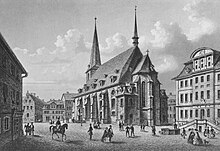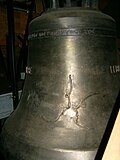Herder Church

The building, popularly known as the Herder Church , is actually called the City Church of St. Peter and Paul and is the most important church building in Weimar . It has served the Evangelical Lutheran community since the Reformation in 1525 .
Since 1998, the Herder Church has been part of the Classical Weimar ensemble on UNESCO's World Heritage List .
history
The first church was built between 1245 and 1249; In 1299 a fire destroyed the building, of which only the foundations remained. The second church building was badly damaged in the city fire in 1424. Today's building goes back to the three-aisled hall church in late Gothic style, which was built between 1498 and 1500. The choir served as the burial place of the Ernestine line of the Wettins .
The nickname Herderkirche carries the building after the theologian and philosopher Johann Gottfried Herder , who until his death in 1803 from 1776 as general superintendent worked in the town church and is buried in the corresponding cemetery. Duchess Anna Amalia was buried there in 1807 . The square in front of the church was also named after him after the herd monument was erected in 1850. On the residential building north behind the town church, a plaque marks Herder's former official residence.
During the air raids on Weimar towards the end of the Second World War , the church was badly damaged by bombs on February 9, 1945 . The 19 meter high pitched roof and the wooden vault were largely destroyed, the remaining stone vaults in the eastern parts collapsed. The entire interior was badly damaged. From 1945 the rubble was removed, from 1948 to 1953 the reconstruction (static protection of the outer walls, erection of the roof and ridge turrets, repair of the west tower, moving in and plastering of new wooden vaults, restoration of the choir arch). The church was consecrated on June 14, 1953. The repair and restoration of the interior was carried out until 1977.
In December 1988, the then superintendent handed over five squatters of the church, who wanted to emphasize their will to leave, to the GDR security organs. The squatters and four associates received long prison terms. After the fall of the Wall it turned out that the superintendent was one of the almost 80 pastors and church workers in Thuringia who had worked closely with the MfS . The Herderkirche and the Herderplatz were important meeting places of the peaceful revolution in the fall of 1989.
The Herderkirche, together with Herder's house and the old grammar school , belongs to the Ensemble Klassisches Weimar , which was declared a UNESCO World Heritage Site in 1998 . In 2012 the Herder Church was accepted into the International Cross of Nails Community of the churches destroyed in World War II.
From 2010 to 2016 the church was extensively restored , including the pulpit, the font and the Cranach altar. This is now protected from UV light by two new church windows with special glazing .
Furnishing
Altarpiece by Cranach
The remarkable three-winged altarpiece of the city church was made according to the latest research by Lucas Cranach the Younger between 1552 and 1555 and was not started by Lucas Cranach the Elder in the year of his death, as was long assumed . Today it is regarded as the main work of Saxon-Thuringian art of the 16th century. In the chancel there is also the original of Lucas Cranach the Elder's grave slab from the Church of St. James . Equally important with the altarpiece is the so-called Luther shrine , a triptych with portraits of Martin Luther .
The Cranach Altar was saved from being destroyed by the air raids on Weimar by being relocated in 1940 .
Princely tombs
From the middle of the 16th century to the beginning of the 17th century, the town church was the princely burial place of the Ernestine Wettins residing in Weimar. The tombs and burials of the following princely persons are still in the town church:
- Elector Johann Friedrich I of Saxony (1503–1554),
- his wife Sibylla von Jülich-Kleve-Berg (1512–1554)
- Agnes of Hesse (1527–1555)
- Duke Johann Wilhelm I of Saxe-Weimar (1530–1573),
- his wife Dorothea Susanne von der Pfalz (1544–1592) - epitaph for Dorothea Susanne von der Pfalz
- Duke Friedrich Wilhelm I of Saxe-Weimar (1562–1602),
- his first wife Sophia von Württemberg (1563–1590)
- Duke Johann III. of Saxony-Weimar (1570-1605),
- his wife Dorothea Maria von Anhalt (1574–1617)
- Duchess Anna Amalia of Braunschweig-Wolfenbüttel (1739–1807)
Anna Amalia, Duchess of Saxe-Weimar-Eisenach, was the last regent to be buried in the city church at her own request in 1807.
organ
The organ of the city church was built from 1998–1999 by W. Sauer Orgelbau Frankfurt (Oder) in the historical case from 1812, with several preserved registers from the Walcker organ from 1908 (which was badly damaged in World War II and 1953/54 and 1964 by Sauer partially restored) and the 1978 Chamade 8 '(on the upper right side gallery) were reused. Today's instrument has 53 stops on three manuals and a pedal with mechanical performance and electrical stop action . The disposition:
|
|
|
|
|||||||||||||||||||||||||||||||||||||||||||||||||||||||||||||||||||||||||||||||||||||||||||||||||||||||||||||||||||||||||||||||||||||||||||||||||||||||||||||||||||||||||||||
- Coupling : III / I, I / II, III / II; Sub and Super III / II; Sub and Super III / III; I / P, II / P, III / P; Super III / P.
- Playing aids : Tutti (push button and piston); Pistons: hand register down, tongues down, crescendo on; Individual racks for the tongue registers, 128 typesetting combinations , tremulants adjustable in speed, crescendo roller , swell step for the III. Manual.
Bells
After Johann Sebastian Bach's time, the town church had six bells . The main chime consisted of four bells, which should have sounded roughly in the notes h 0 , d flat 1 , f sharp 1 and h 1 . The large bell, which weighs around 4,300 kilograms, was last cast in 1606 by Erfurt master Hermann Königk and only rang on the high holidays. In 1632, Jakob König cast the death bell , which together with the confession bell cast by Wolf Hilliger in 1566 formed the Sunday bells. The Marienglocke came from the pre-Reformation period; it was cast in 1294 and rang on weekdays with the confessional bell . The ridge turret still housed the guard bell from 1680, on the main tower there was the storm bell and clock bell . The three big bells were melted down for armaments purposes during the First World War . The old Marienglocke was traded in in 1922 for a new iron bell from the Schilling and Lattermann foundry . These bells were named Luther , Herder and Bach . After more than 80 years, they had reached their limits and should be replaced by new, bronze ones. Among other things, the members of the Association for the History of Berlin donated for the new cast . In 2009, the Rudolf Perner bell foundry in Passau cast three bells, which were lifted into the belfry of the Weimar city church on September 28 of the same year. On Reformation Day 2009, the bells was put into service. The three new bells are called Luther (eternity bell , striking tone h 0 , weight 3,000 kg), Herder (peace bell, striking tone c sharp 1 , weight 1,930 kg) and Bach (baptismal bell, striking tone e 1 , weight 1,382 kg). The new bells were coordinated with those of the castle tower , the Roman Catholic Church of the Sacred Heart of Jesus and the Church of St. James. The decoration of the new bells comes from Walter Sachs .
| photo | Foundry / casting location |
Font type | year | Ø (mm) | Weight (kg) | Nominal | Bell decorations and inscriptions |
Bell story |
|---|---|---|---|---|---|---|---|---|
| Rudolf Perner GmbH & Co. KG (Passau) | bronze | 2009 | 1650 | 2650 or 3000 kg |
h0 | Shoulder between two round tires / Church of St. Peter and Paul Weimar 2009 / shoulder (other side) / caster characters / edge / SOLA FIDE SOLA GRATIA SOLA SCRIPTURA / [Line Relief: Pray - Woo; Line relief: blessing and helping; Line relief: reading] (jewelry by Walter Sachs) | 1566 bronze bell Wolff Hillinger d. J. or Hilger (Freyberg); Burst in 1587 ; 1587 bronze bell Melchior Möring [k] (Erfurt); Burst in 1588 ; 1589 bronze bell Melchior Möring [k] (Erfurt); 1602 cracked; 1604 bronze bell Hermann König [k] (Erfurt); Loss in World War I (melt down); 1922 iron chill casting bell Schilling & Lattermann (Apolda and dawn); Delivered to the Holzdorf estate in 2011 | |
| Rudolf Perner GmbH & Co. KG (Passau) | bronze | 2009 | 1460 | 1850 or 1930 |
c sharp1 | Shoulder between two round tires / Stadtkirche St. Peter and Paul-Weimar 2009 / Shoulder (other side) / Gießerzeichen / Flanke / Light, Love, Life / [Line relief: In contemplation (thinker); Line relief: In affection (mother, child); Line relief: tree] (jewelry by Walter Sachs) | 1632/37 bronze bell Jacob König [k] (Erfurt); 1850 fire-crack; 1851 bronze bell Carl Friedrich Ulrich (Apolda) [not entirely pure in sound]; Loss in World War I (melt down); 1922 Chilled cast iron bell Schilling & Lattermann (Apolda and Morgenröthe) No. 3619; Delivered to the Holzdorf estate in 2011 | |
| Rudolf Perner GmbH & Co. KG (Passau) | bronze | 2009 | 1250 | 1200 or 1382 |
e1 | Shoulder between two round tires / Church of St. Peter and Paul Weimar 2009 / shoulder (other side) caster character edge / SOLI DEO GLORIA / [Line Relief: wind; Line relief: strings; Line relief: singer] (jewelry by Walter Sachs) | 1566 bronze bell Wolff Hillinger the Younger or Hilger [Bergner / Mende] (Freyberg); 1616 casting; 1851 bronze bell brothers Ulrich (Apolda); 1888 bronze bell Franz Schilling as CF Ulrich (Apolda) No. 597; Loss in World War I (melt down); 1922 Chilled cast iron bell Schilling & Lattermann (Apolda and Morgenröthe) No. 3620; Delivered to the Holzdorf estate in 2011 |
See also
- List of churches in Weimar
- List of organs in the district of Weimarer Land and in the city of Weimar
- List of bells in the Weimarer Land district and in Weimar
literature
- College of authors: The word of God remains - Weimar city church history in the 20th century. Published by the Parish Council of the Evangelical Lutheran Parish Weimar on the occasion of the 500th anniversary of the City Church of St. Peter and Paul on June 24, 2000. Format A5, 68 pages, Weimar 2000, without ISBN.
- Ricklef Münnich: The city parish Weimar and the Weimar Jews under National Socialism. In: Erika Müller, Harry Stein: Jewish families in Weimar. Your persecution and destruction. Weimar 1998, ISBN 3-910053-31-9 , p. 217 ff.
Web links
- Literature about the Herder Church in the catalog of the German National Library
- Homepage of the Evangelical Parish Weimar with information about the Herder Church ( PDF ; 1.2 MB)
- Information on the donation campaign by the Evangelical Parish Weimar for the new bronze bells of the Herder Church
- More information and pictures of the Herder Church at Monumente Online
Individual evidence
- ↑ Pictures of Destruction. Weimar 1945. Photos by Günther Beyer . Catalog for the exhibition in the Stadtmuseum 2015. p. 53.
- ^ Rudolf Zießler: District of Erfurt . In: Götz Eckardt (ed.): Fates of German architectural monuments in the Second World War . Henschel-Verlag, Berlin 1978. Volume 2, pp. 489-499.
- ↑ From the Herder Church it went straight to jail. 25 years ago, the then Weimar superintendent handed over five church squatters to the GDR authorities . Thuringian newspaper, December 3, 2013.
- ↑ Cross of nails urges reconciliation . Thuringian State Newspaper, December 17, 2012.
- ↑ RBB kulturradio: Festival service for the reopening of Weimar Herder Church ( Memento of the original from December 1, 2016 in the Internet Archive ) Info: The archive link has been inserted automatically and has not yet been checked. Please check the original and archive link according to the instructions and then remove this notice. , November 29, 2016.
- ↑ Evangelical Lutheran Church Congregation Weimar: Second construction phase in the city church St. Peter and Paul (Herderkirche) , accessed on December 1, 2016.
- ^ Mirko Krüger: Cranach in Thuringia: preliminary drawing discovered under the color . Thuringian General . April 26, 2011. Retrieved October 20, 2015.
- ↑ Weimar, St. Peter and Paul (Herder Church) . www.organindex.de. Accessed August 6, 2018.
- ↑ Dispositions of the various organs in the Weimar Herderkirche from 1812 to the present in the organ database . www.orgbase.nl. Accessed August 6, 2018.
- ↑ From the Walcker organ (1908).
- ↑ From the Walcker organ (1908).
- ↑ 1978 added by Sauer to the upper right side gallery; currently shut down.
- ↑ From the Walcker organ (1908).
- ↑ From the Walcker organ (1908).
- ↑ From the Walcker organ (1908).
- ↑ From the Walcker organ (1908).
- ↑ From the Walcker organ (1908).
- ↑ From the Walcker organ (1908).
- ↑ From the Walcker organ (1908).
- ↑ From the Walcker organ (1908).
- ↑ From the Walcker organ (1908).
- ↑ From the Walcker organ (1908).
- ↑ Bernd Mende: The bells of the Weimar castle church . Weimarer Schriften, Vol. 62, Weimar 2008, p. 9.
- ↑ Jörg Kluge: Bells for the Herder Church in Weimar . In: Communications of the Association for the History of Berlin, Issue 4, October 2009, p. 286.
Coordinates: 50 ° 58 ′ 52 ″ N , 11 ° 19 ′ 45 ″ E








